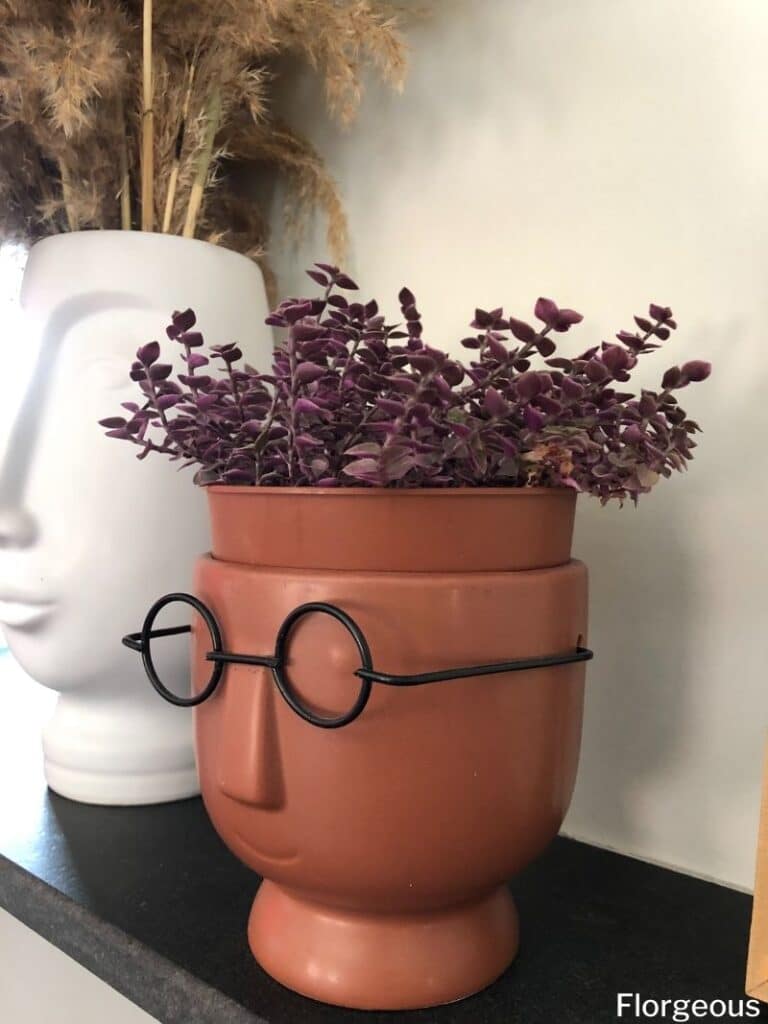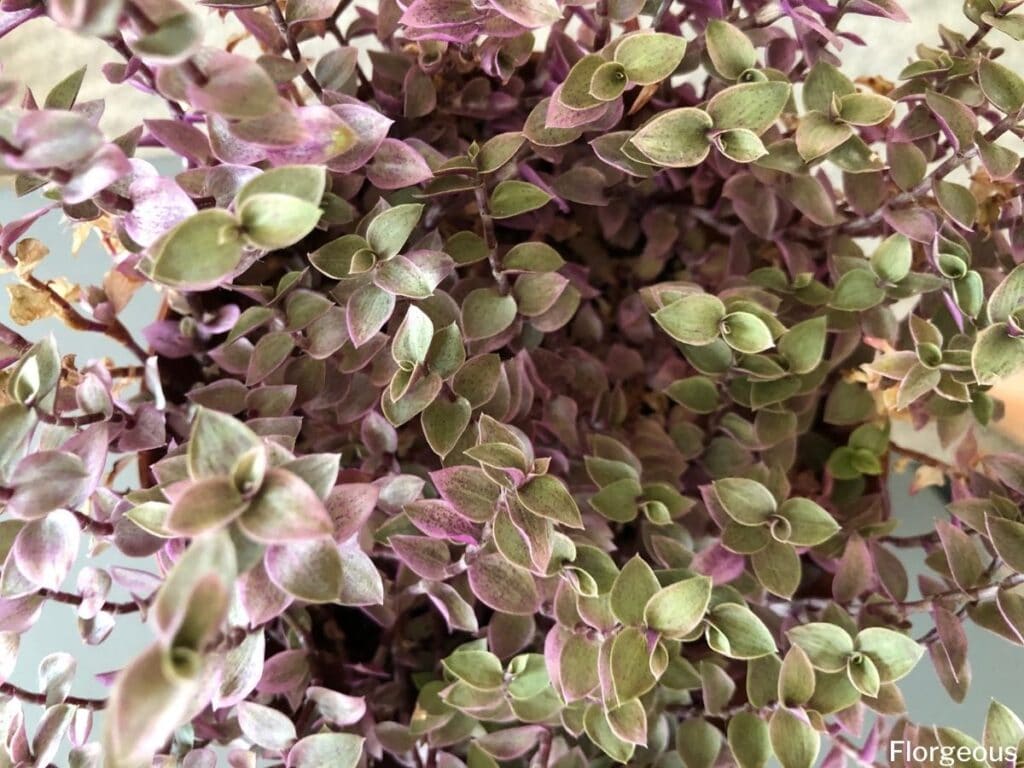A genus of flower plants in the spiderwort family, Callisia is a group of plants that includes those that are commonly and affectionately referred to as roselings. Native to the Western Hemisphere from the southern US to Argentina, this plant is known for its beauty and ease of growth.
This plant is known above all for its gorgeous flowers. In fact, the genus name Callisia is derived from the Greek word “kallos,” which means “beauty.” With foliage that feels rubbery to the touch and delicate flowers in white, pink, and other colors, this lovely plant is worth a second thought.
There are many different species of this genus to consider growing, including the famed Callisia fragrans, C. graminea, and C. rosea. Some, like C. rosea (also known as Piedmont roseling) have delicate pink leaves while others are white or deep purple. Some, like Callisia repens (Callisia Pink Panther), are best known for their foliage and creeping growth habit instead of their flowers.
There are lots of different features to choose from, but in most cases, all are easy to grow and require very little maintenance.
Let’s dive in to learn everything you need to know about cultivating this attractive houseplant!
Plant Facts
| Scientific name | Callisia |
| Common names | Callisia, roselings, pink lady |
| Family | Commelinaceae |
| Plant Type | Houseplant |
| Height and Width | 0.5–1 ft. tall (indoors), 0.5-1 ft. wide (indoors) |
| Origin | Southern US, Central and South America |
| Flower colors | Pink, white, purple, etc. |
| Foliage color | Dark and light green |
| Sun Exposure | Indirect sunlight or parietal shade |
| Soil Type & pH | Sandy, acidic soil |
| Special features | Low Maintenance, good for containers, attracts pollinators, can be toxic to pets |
How to Grow Callisia
A native perennial, callisia is closely related to other spiderworts. It is known for its ability to tolerate just about everything, from intense heat and humidity to the threat of disease. A low-maintenance plant, callisia requires minimal care, growing best in partial shade and sandy, acidic soil.
Growing zones vary depending on which type of callisia you grow, but in most cases, it can be grown outdoors in plant hardiness zones 6A to 9B. However, most people choose to grow this specimen as a houseplant to add interest to the home without a lot of fuss and maintenance.
In addition to planting in sandy, acidic soil, keep in mind that, if you grow your callisia outdoors or even on a sunny windowsill, you may have a few visitors! Pollinators of all kinds love clusia plants, so you may find that you have some new friends stopping by your windowsill.

Propagation
This houseplant can be propagated by seeds or by division. To propagate by seed, either sow seeds in the spring in moist seed-starting mixture or get your own seeds by working with mature plants. The indoor plants bloom from spring until early summer, opening in the morning and closing by mid-afternoon.
The fruits of these plants mature no later than three weeks after flowering. Once the capsule becomes dry and papery, you can split it open to release the seeds. These can be scattered freely in the garden, where they will germinate in about two weeks or sown in seed starting trays indoors.
You can also choose to propagate your plant by taking stem cuttings in the fall.
To do this, cut off a stem you’d like to keep, ideally one with a few green leaves. Strip the bottom two to three leaves, then place the stem in the container, inserting it in the soil only up to the point where the leaves start. Use a mixture of potting soil and perlite for this. Once you see new leaves, that’s a sign that rooting has occurred and you can transplant the callisia to a new pot.
Soil
Most types of callisia prefer fertile and lightly moist soil. Acidic soil is preferred. Use well-draining soil that contains about 50/50 potting soil with perlite or succulent mix.
Additionally, incorporating a layer of peat moss into the soil can help improve drainage and prevent root rot while retaining essential water and nutrients for your plants. Be cautious not to overwater, as soggy soil can harm the plant’s roots.
Pruning
Pruning is not necessary when it comes to caring for your plant, but it can help it look a bit more attractive. Simply pinch the growing tips every now and then when your plant starts looking a bit bedraggled. Pinching the growing tips will help the plant grow in a more compact form.
You can trim the plant if it becomes extremely straggly. It will regrow well even after an intense, heavy handed haircut!
Repotting and Transplanting
Report your plant once every three years. Do so into a houseplant-specific potting mix and consider adding a bit of succulent potting mix into the container to ensure that it drains well, too.
Be careful handling the roots when you transplant your potted plants, as it is prone to wilting if it experience any transplant shock at all.
Callisia Care Guide
Now that you know what to look for in a plant and how to start growing it, here are some tips to help you keep your plant alive and growing well!
Water
Again, this is not a plant that enjoys having its feet wet! Avoiding excess water. Make sure you allow your plant to dry out between waterings. Less than an inch of water per week, in most cases, is desired.
Use only planters with adequate drainage holes. Otherwise, you may find that your plant develops fatal conditions like root rot or fails to grow as expected. Watering once every three to four days is usually sufficient.
Sunlight
Keep your callisia in bright, indirect light when grown indoors. Some varieties of callisia prefer a bit more partial shade, while others like more direct sunlight, especially when you’re growing outdoors. Be sure to pay attention to the requirements of the specific type of plant you are growing to know for sure.
In most cases, full sun is recommended in the winter but in the summer, avoid too much sunlight to prevent the leaves from burning.
Temperature and Humidity
Warmer temperatures are preferred by this plant. Ideally, these should be above 70 degrees Fahrenheit or more. In the winter, you can drop the temperature range a bit lower – around 50 to 60 degrees is fine, as this will mimic the natural period of dormancy the plant would have in the wintertime.
As for humidity, you shouldn’t have to do too much in order to ensure proper levels for your plant. The levels that most of us prefer in our own homes are generally adequate for callisia – no need to mist or run a humidifier to keep this gorgeous specimen content.
If the leaf tips start to turn brown, it may be due to too low humidity. To keep your plant happy, either mist the leaves once a week or add a humidity tray.
Fertilizer
Fertilize your callisia plant with a regular 10-10-10 liquid fertilizer in the spring, summer, and fall months. You can apply this about once a month but stop fertilizing in the winter which is the planet’s period of dormancy. You should also water less often during this time to ensure the plant has an adequate rest period before it goes back into the growing season.
Pest and diseases
Pests and diseases that can affect Callisia include spider mites, aphids, mealybugs, and scale insects, which may infest the plant and damage its foliage. Overwatering can lead to root rot, while underwatering can cause wilting and dehydration. Powdery mildew, leaf spot disease, and fungal infections may occur in humid conditions or if the plant is kept in poorly ventilated areas.
To prevent these issues, maintain good air circulation around the plant, avoid overwatering, and inspect regularly for signs of pests or diseases. If detected, treat promptly with insecticidal soap for pests or fungicides for fungal infections, following label instructions. Pay close attention to the health of the leaf tips as they can be an early indicator of problems.
Common Varieties and Cultivars
There are many callisia species and varieties you might consider growing in your home, including:
- C. cordifolia (Florida roseling)
- C. fragrans (Basketplant)
- C. gentlei
- C. graminea Grassleaf roseling)
- C. navicularis
- C. ornata (Florida scrub roseling)
- C. repens (Creeping inch plant)
- C. rosea (Piedmont roseling)
FAQs
Does Callisia need sunlight?
Callisia plants generally prefer bright, indirect sunlight, although they can tolerate some shade. Providing them with moderate to bright light indoors or filtered sunlight outdoors is ideal.
How often should you water Callisia?
Water Callisia when the top inch of soil feels dry, typically every 1-2 weeks. Adjust watering frequency based on factors like temperature, humidity, and the size of the pot.
Is Callisia an indoor plant?
Callisia species, including Callisia repens (Bolivian Jew) and Callisia fragrans (Inch Plant), are often grown as indoor plants, but some varieties can also thrive outdoors in suitable climates.
How much light does Callisia pink Lady need?
Callisia Pink Lady, a cultivar of Callisia repens, prefers bright, indirect light indoors. Place it near a window where it can receive plenty of filtered sunlight, but avoid direct sunlight, which can scorch its leaves.
What is the difference between Callisia repens pink lady and pink panther?
Callisia repens Pink Panther has larger leaves with intense pink undersides, while ‘Pink Lady’ features smaller leaves with pink variegation throughout. Additionally, Pink Panther plant tends to grow more upright, while ‘Pink Lady’ has a compact shape, trailing habit.
Conclusion
In conclusion, successful care of Callisia plants ensures their resilience and vibrancy in indoor and outdoor settings. By adhering to the plant care tips in this article, gardeners can foster flourishing specimens.
Whether cultivating Callisia for its ornamental appeal or ground cover function, attention to detail and proactive care practices contribute to the overall health and aesthetic charm of these versatile plants in diverse gardening environments.







